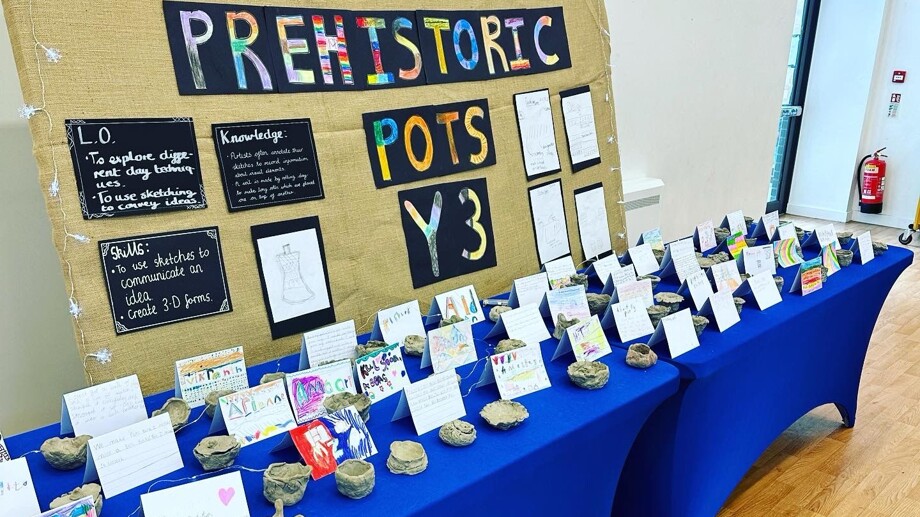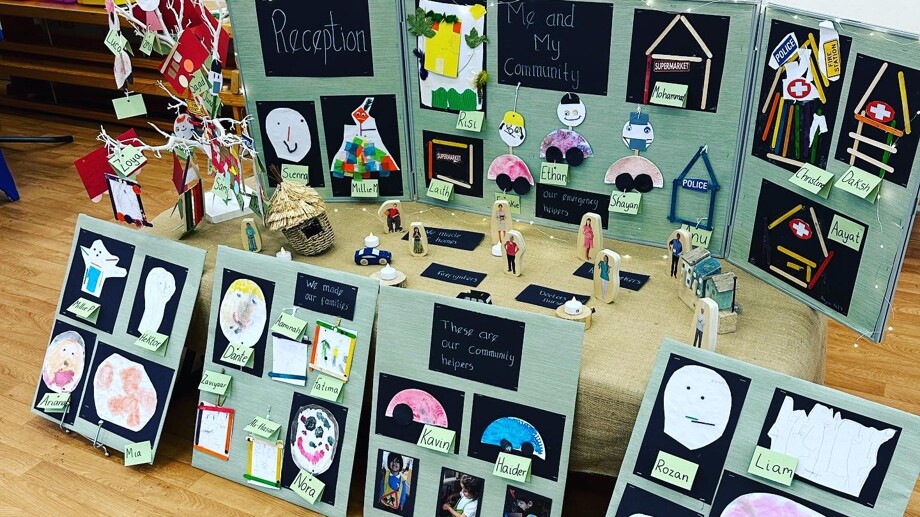Art & Design
Intent
At our primary school, we are committed to fostering a vibrant and inclusive environment where every child can explore, express, and appreciate the world of art. Our intent is to cultivate a deep-seated love and understanding of art among our students, enabling them to unleash their creativity, develop critical thinking skills, and cultivate a sense of cultural appreciation.
Through our art curriculum, we aim to:
- Nurture Creativity - We believe in providing ample opportunities for students to experiment with various artistic mediums, techniques, and styles, encouraging them to think outside the box and express themselves authentically.
- Foster Expression - We strive to create a safe and supportive space where students feel empowered to express their thoughts, emotions, and unique perspectives through art, fostering self-confidence and self-awareness.
- Cultivate Skills - Our curriculum is designed to develop foundational art skills such as drawing, painting, sculpting, and more, while also emphasising the importance of craftsmanship, patience, and perseverance in the creative process. We aim to expose students to a diverse range of artistic traditions, movements, and artists from around the world, fostering an appreciation for cultural diversity and promoting empathy and understanding.
- Celebrate Achievement - We celebrate and showcase student artwork both within our school community and beyond, recognizing and valuing each student's unique artistic journey and accomplishments.
Through these efforts, we aspire to cultivate lifelong learners who are not only proficient in artistic skills but also possess the creativity, resilience, and cultural awareness needed to thrive in an ever-changing world.
Implementation
Key Stage 1
Each autumn term begins with essential skills and knowledge projects (Mixing Colours in Year 1 and Exploring Colours in Year 2). Teaching these projects enables children to be introduced to and then revisit colour mixing and the colour wheel with plentiful opportunities for the children to explore primary and secondary colours and hues.
In Year 1, children explore themes directly related to the children themselves, such as their facial features, the surrounding natural world and their local community. In Year 2, the projects expand children’s artistic horizons to study a more comprehensive range of artists, artistic movements and creative techniques.
Lower Key Stage 2

Each autumn term begins with essential skills and knowledge projects (Colour Theory in Year 3 and Warm and Cool Colours in Year 4). Teaching these projects enables children to build on their previous understanding of colour and further develop their expertise by studying tertiary, analogous and complementary colours with many opportunities for the children to explore warm and cool colours.
In Year 3, children expand their experiences to study a broader range of art forms, artists and genres. They also begin to study art from specific and diverse periods of history, including prehistoric pottery and Roman mosaics. Other genres studied in Year 3 build on previous techniques learned in Key Stage 1 and include more complex techniques in printmaking, drawing, painting and textiles.
In Year 4, children develop more specialised techniques in drawing, painting, printmaking and sculpture. They explore ways in which ancient cultures have influenced art and crafts by studying, for example, medieval weaving techniques and the religious significance of Islamic art.
Upper Key Stage 2
Each autumn term begins with essential skills and knowledge projects (Colour in Landscapes in Year 5 and Colour and Style in Year 6). Teaching these projects enables children to build on their previous understanding of colour theory and develop further expertise with colour by studying tints, shades and tones and more complex colour palettes.
In Year 5, children develop and combine more complex artistic techniques in a range of genres, including drawing, painting, printmaking and sculpture. Children continue to build on their understanding of other historical periods and cultures by studying the ancient Chinese art form of taotie and the significance of the Expressionist movement.
In Year 6, children are encouraged to work more independently in projects like Environmental Artists and Distortion and Abstraction. Such projects require them to consider more conceptual representations of personal, environmental, social or political messaging. Children explore diversity in art by studying the projects Inuit and Trailblazers, Barrier Breakers.
Impact

Upon leaving Ascot Road School, children will have acquired a foundational understanding and appreciation of art, encompassing both practical skills and conceptual knowledge. Specifically, they will:
- Possess Basic Artistic Skills: Children will have developed fundamental skills in drawing, painting, sculpting, and other artistic techniques. They will understand how to use various art materials and tools effectively to create visual representations of their ideas.
- Understand Elements and Principles of Art: Students will be familiar with the elements of art (such as line, shape, colour, texture, form, space) and principles of design (such as balance, contrast, emphasis, movement, pattern, unity), enabling them to analyse and discuss artworks with a critical eye.
- Appreciate Art History and Cultural Diversity: Children will have been exposed to a variety of art styles, movements, and artists from different cultures and time periods. They will understand how art reflects and shapes culture, history, and society, fostering cultural awareness and empathy.
- Express Creativity and Imagination: Through artistic exploration and experimentation, children will have learned to express their thoughts, emotions, and experiences creatively. They will understand that there are multiple ways to approach and interpret art, encouraging them to think creatively and independently.
Overall, children leaving Ascot Road School will have a solid foundation in art that prepares them for further exploration and development of their artistic abilities, whether pursuing art as a hobby or as a potential career path. Additionally, they will carry with them an appreciation for the beauty and significance of art in enriching their lives and the world around them.
What does Art look like in Reception?
 Art in the Early Years Foundation Stage (EYFS) is closely aligned with the Development Matters framework, supporting holistic development in children aged 0 to 5.
Art in the Early Years Foundation Stage (EYFS) is closely aligned with the Development Matters framework, supporting holistic development in children aged 0 to 5.
Through sensory exploration, open-ended activities, and imaginative play, art fosters communication, physical skills, social-emotional development, literacy, mathematics, understanding of the world, and expressive arts and design. Children engage in a variety of art experiences that encourage creativity, self-expression, collaboration, and appreciation for diversity, laying a foundation for lifelong learning and artistic exploration.
How are SEND children supported with Art and Design?
Children with a SEND need, access art in primary schools through inclusive approaches that accommodate their individual needs and abilities. Strategies include differentiated instruction, visual supports, sensory integration, adaptive equipment, peer support, choice and autonomy, individualised goals, and celebrating diversity. These practices ensure that SEND children have equal opportunities to engage in art, develop creativity, and express themselves alongside their peers, fostering a sense of belonging and achievement.
Culture
Our school fosters a vibrant culture of Art and Design through a comprehensive curriculum, that has included:
- Dedicated display boards to showcase every year group’s art project
- KS1 After School Art club run by our passionate Learning Support Practitioner
- Artist Workshop for Year 6 children
- An enriching trip to the ‘Tate Modern’ for Year 4 children
- Our children were shortlisted in a local community Art Competition
- Children showcase and celebrate artwork in Celebrations assembly
The Headteacher teachers Art to a year group every half term, sharing her passion, experience and portfolio of artwork. Our commitment to nurturing creativity and appreciation for the arts empowers students to explore their talents, develop skills, and contribute to our rich artistic community.





